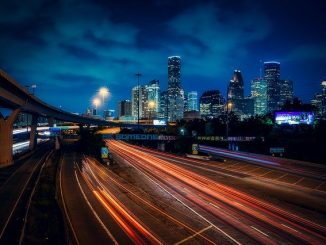
The Chronicle ran an interesting column from Lisa Falkenberg yesterday.
With recent stories on red light cameras, Falkenberg started wondering why the traffic lights downtown are “synchronized” in a way that makes little sense (that is to say, they all turn red or green at once, rather than maximizing the numbers of lights that a vehicle moving at an optimal speed can get through).
So she started to ask some of the city’s experts.
Wes Johnson, spokesman for the Department of Public Works and Engineering, told me the lights were programmed “in sync” several years ago to help simplify traffic patterns during major downtown road construction.
But that construction was finished a few years ago. Why haven’t the lights changed back?
Johnson wasn’t sure. “It’s real complicated,” he said. “It’s like rocket science. I’ve tried to get those guys to explain it.”
That’s just the way it is. Not to worry. Move along.
Another public works spokesman, Alvin Wright, tried to convince me that the lemminglike traffic-light pattern was “progress.” He said it was part of a major mobility project and was helping reduce commute times.
I argued with him, then asked to speak with an expert. “We’ll get you educated,” Wright joked.
That’s just the way it is. Not to worry. Move along, tee hee!
Finally, the expert, assistant public works director Jeffrey Weatherford, validated my concerns. He said he asked the same questions when he moved here from Arizona last year.
The traffic pattern downtown and in midtown’s fringe isn’t exactly progress, he said. It’s a holdover from the heavy construction era. And the proper term for it is “simultaneous green.” (Simultaneous red seems more accurate.)
“The driving habits right now of the public when you’ve got the simultaneous green are that it entices them to try and see if they can get that last green,” Weatherford said. “And we don’t want that.”
Weatherford, who oversees Houston’s traffic operations, said the “simultaneous green” remains for two reasons: Staff resources were focused on other parts of town and, when it was implemented, the public responded favorably.
Apparently, he said, drivers were delighted to see all the lights turn green at once and they felt like “gee, the system is working right.”
The lights must have been really screwed up before, I thought. How could the stop-and-go pattern be an improvement?
Oh, it was really screwed up before. Falkenberg is lucky she came to the city after the Lee Brown era (or error, if you prefer).
Nonetheless, from “really screwed up” to “halfway screwed up” isn’t the best we can do (and it certainly falls short of “world class”), especially after all the PR emissions from the administration on synchronizing lights and improving mobility.
Falkenberg notes that Weatherford has a project in the works to reprogram downtown north-south lights in a progressive pattern, but that he first has to build public support. Here’s wishing him well in his efforts (maybe the mayor’s PR staff could even help him out). Because like Falkenberg, I can’t see why anyone would prefer traffic light eye candy to actual improvements in mobility.
(Old) Forum Comments (21)



